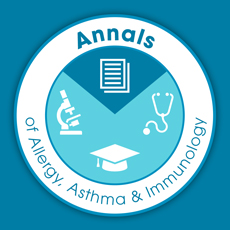 Well, we are all finally into the fall season in North America and there are signs of autumn everywhere ̶ even in the deep South where we have had amazingly warm weather to date. It is finally cooling down. All the football teams (high school, college, pros) are far enough into their seasons that the playoff picture is beginning to come into focus. That will allow many of us to slow down a bit and take time to peruse the October issue of the Annals of Allergy, Asthma and Immunology. I want to provide my thoughts on the whole issue and particularly some “don’t miss” reading opportunities.
Well, we are all finally into the fall season in North America and there are signs of autumn everywhere ̶ even in the deep South where we have had amazingly warm weather to date. It is finally cooling down. All the football teams (high school, college, pros) are far enough into their seasons that the playoff picture is beginning to come into focus. That will allow many of us to slow down a bit and take time to peruse the October issue of the Annals of Allergy, Asthma and Immunology. I want to provide my thoughts on the whole issue and particularly some “don’t miss” reading opportunities.
This month, the emphasis is on asthma – causes, classifications and approaches to therapy. We have multiple articles in various formats – perspectives (evidence-based opinion pieces meant to challenge our own personal paradigms to stimulate us to increase our knowledge for our patients), review articles from some of the world leaders in various aspects of asthma research, original articles and letters. I am going to focus on three articles in this column that you will not want to miss.
First is a thought-provoking Perspective by Sandra E. Zaeh, MD, MS, Michelle N. Eakin, PhD, and Meredith C. McCormack, PhD from Johns Hopkins who discuss Key Policies to Support Asthma management for Children. The authors outline what most of us would agree is a rational approach to pediatric asthma management, then address some of the challenges and barriers we all face in our efforts to assist these kids and their families. In many instances, for reasons that can be beyond financial, children often have inadequate access to controller medications (particularly inhaled corticosteroids and reliever medications) which have a long and well-known track record in promoting disease control and decreasing severity of exacerbations. In addition to access to meds, there are challenges in access to asthma specialists. This can be because of gaps in Medicaid/CHIP programs, but also can be issues with limiting of referrals by primary care providers who may not fully appreciate the value of co-management of these children with asthma specialists. The authors provide an excellent perspective that includes specific policy approaches for us to support in our various spheres of influence that can relieve some of these challenges for these kids.
A review article by Irene Mikhail, MD and Mitchell H. Grayson, MD, FACAAI, from Nationwide Children’s Hospital in Columbus, OH masterfully describes the relationships between viral infections and asthma. They summarize much of the evidence demonstrating a link between early viral infections, especially with rhinoviruses (RV) and respiratory syncytial virus (RSV), and asthma inception and exacerbations. RV-induced wheezing is an important risk factor for asthma, primarily when atopy is present, with much evidence supporting the idea that sensitization as a risk factor for early RV-induced wheezing, which in turn is a risk factor for asthma. RSV, on the other hand, is a more important risk factor for non-atopic asthma, with severe infections conferring greater risk. They present compelling evidence to support the need for understanding these complex relationships in developing asthma prevention strategies and targeted asthma therapies.
Another high impact review comes from Diego Jose Maselli, MD and Nicola Alexander Hanania, MD at Baylor College of Medicine who offer a revealing look at the evolving clinical issues surrounding management of patients with asthma – COPD overlap (ACO). For a time, attempts were made to label this a syndrome, but this is largely being abandoned because of lack of evidence for a distinct disease process separate from asthma or COPD. Patients with ACO tend to have greater morbidity than asthma or COPD alone, yet the information on the best therapeutic approach to this group of patients is still limited. Current treatment recommendations rely on expert opinions, roundtable discussions and strategy documents as most clinical studies in asthma and COPD have excluded patients with ACO. Due to the potential risk described in patients with asthma with the use of long-acting beta 2 agonist monotherapy, it is recommended that initial therapy for patients with ACO include a long-acting bronchodilator in conjunction with an inhaled corticosteroid. Long-acting muscarinic antagonists are effective in both asthma and COPD and should be considered in ACO as an add-on treatment. If inhaler therapy is not effective, advanced therapies based on phenotyping and identification of treatable traits may be considered. Future studies need to determine best strategies for the treatment of patients with ACO focusing on targeting its different phenotypes and its treatable traits.
As always, we would love to hear from you about these and other features in our journal. Feel free to contact me directly or stop me at the Annual Meeting next month in Houston. I look forward to meeting and speaking with many of you.
Gailen D. Marshall, Jr., MD, PhD, FACAAI
Editor-in-chief

